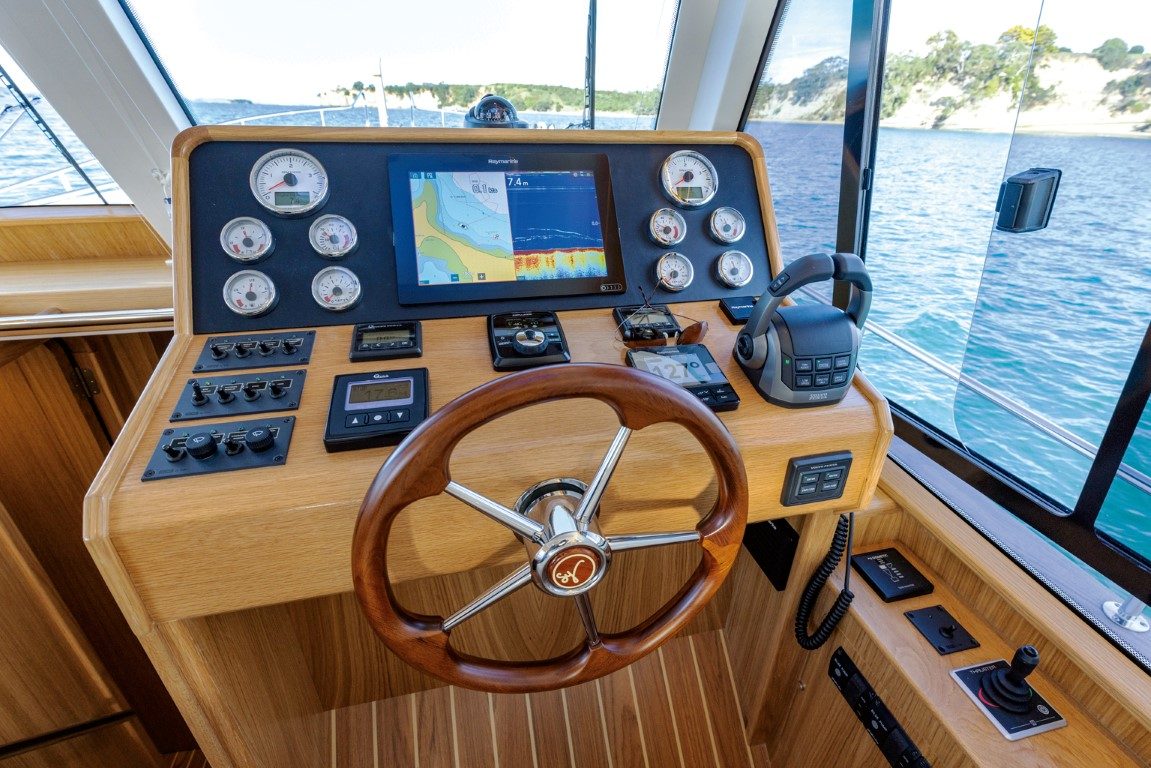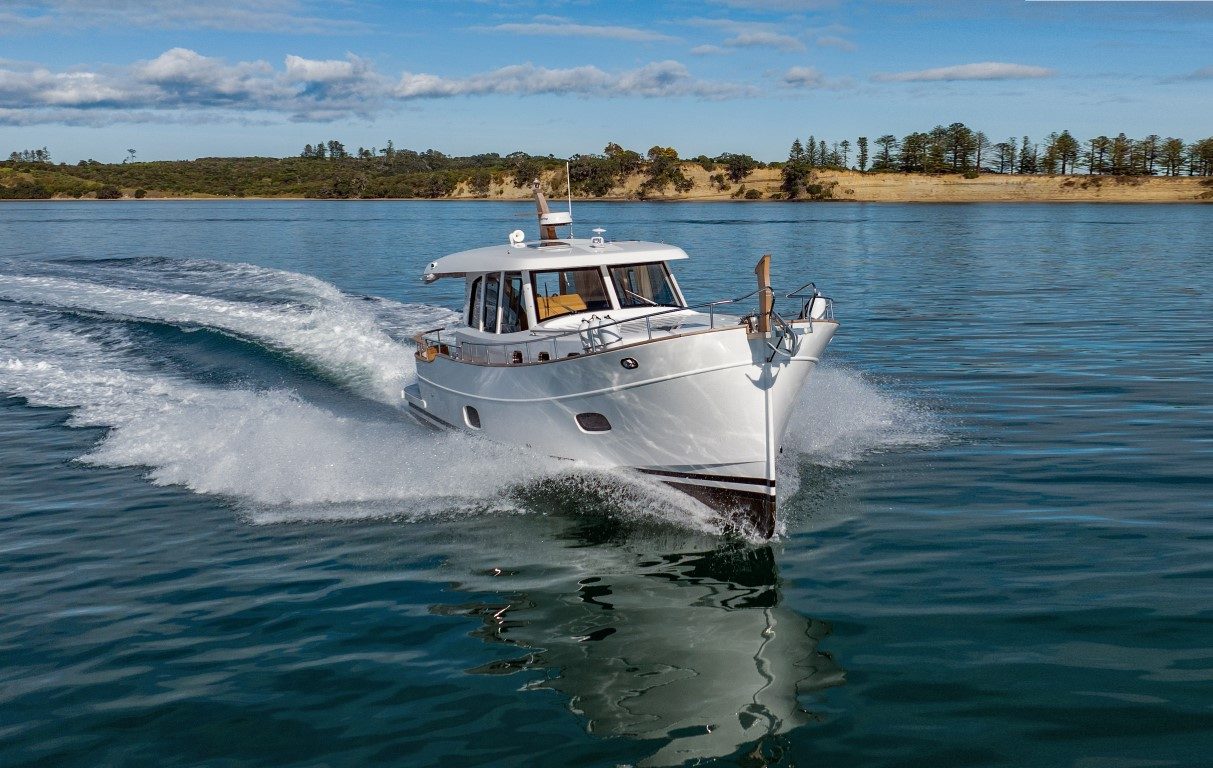‘Behemoth’ is a word which springs to mind or, perhaps more nautically, ‘leviathan’.
- Immaculate finish and real personality
- Galley-style kitchen
- Covered aft deck, with side curtains
- Heating in winter appreciated
Cruising the Mediterranean, relaxing in warm sunshine and anchoring in a perfect bay every night has been a fantasy for many Kiwis over the past couple of covid-affected years — not to mention more recently, in the depths of a very wet winter. Well, if you can’t go to the Mediterranean, this new trawler-style launch can bring the Med to you.
Earlier this year Boating profiled the Menorquín 34 HT, built in the Spanish Balearic Islands by Sasga Yachts. This is its big sister, the 13-metre-long Menorquín 42 HT, and she shares some of the same distinctive features.
The Menorquín range (pronounced Men-or-keen) are based on the look and shape of a traditional small Balearic fishing boat, the llaüt. From its rounded stern to its swept-up sheerline, oval portholes and wooden stem post on the foredeck and the timber radar block on top of the cabin, these boats retain a classic look while offering all the comforts you’d expect from a modern cruising launch. As well as the smaller, 10.5-metre 34, which has found a home in the Marlborough Sounds, there’s also a 16.6-metre long 54 model, one of which is heading for New Zealand next year, and a 21-metre model (the 68), which comes as a flybridge model only. The HT in the Menorquín 42’s name means hard top, so the boat has a sedan-style layout, though a flybridge version is available.

Chrisy Bird, who along with Bruce McGill is the local agent for the marque, first came across this style of boat during an extended period cruising and working in the Med. These boats are built in Menorca, the second largest of the Balearic Islands, by an established family boatbuilding business.
“There are lots of these boats over there, and one of the big things about them is that they are really seaworthy,” Bird says. “The seas around the Balearics and elsewhere in the Mediterranean can be quite short and sharp and can be quite mean, so these boats are designed to be seaworthy in a range of conditions.” She adds that the Menorquíns often appeal to sailors wanting to step back from active cruising into something more leisurely, but still wanting a safe and comfortable ride and a traditional boat look.

The other thing about this particular model which will appeal to local owners is the galley-style kitchen arranged along the port side of the saloon. The other option is to have it forward and down on the lower cabin level, with an extra settee in the saloon, but with this layout the chef can remain part of the action and be enjoying the view out while meals are prepped.
The Kiwi owner of the 34 HT was particularly impressed with its construction and standard of finish, and the same can be said for the 42. The boat has the look of being hand-made rather than factory produced — Sasga makes fewer than 25 boats a year — with neatly finished traditional looking timber work throughout, including a teak decks inside and out, a timber cap-rail on the bulwark and timber detailing under the hardtop out in the cockpit. The helm station is a work of art, too, with a classic timber and chrome wheel and analogue dials providing a classic look amid the mod-cons and electronics, such as the large Raymarine screen, joystick controls for the bow thruster, and the Zipwake automatic trim system monitor.

Due to the boat’s four-metre beam and the generous walkarounds on each side of the cabin, the saloon is not hugely wide, but there’s more than enough room for that galley to port — with a ceramic stovetop with two hobs, an electric oven with microwave, an under-bench fridge and a top-load freezer — for the five of us to sit comfortably around the table to starboard. (There’s another a drawer fridge under the helm seat, too.) The saloon seating area feels nicely elevated, with glass all around for great views and skylights above to give it the feel of a conservatory. A flat-screen TV also pops up out of the cabinetry on the port side if further entertainment is required.
Down below there are three double cabins: a twin to starboard and a double to port under the saloon, and the owner’s cabin in the bow. Also to starboard is the day head and shower, with the generous freeboard providing plenty of headroom here. The master cabin also has a full ensuite head and shower room to port, with timber detailing for a nautical look and large hatch above letting in plenty of light.

We managed to get one of the few fine days amid Auckland’s epically wet winter and head out onto the Waitemata. The only drawback to it being so clear and sunny is that it is extremely cold — but no matter, we can maintain our Mediterranean illusion by turning on the central heating in the cabin. This is only the 42’s second time out of the dock, and she still has that delightful ‘new boat’ smell.

We head off down a glassy harbour, and once past the low-speed zone accelerate comfortably into 15-knot cruise. The boat is powered by a pair of Volvo D4 320hp diesels —moderate units for a boat this size but which provide plenty of power to push her up as far as 23 knots as a top speed. She sits comfortably in displacement mode and climbs up to planing speed without digging in at the stern, keeping the ride level and maintaining good visibility forward. There isn’t any chop to speak of to test out her seaworthiness, but she feels solid and stable, even when we’re turning her in donuts for the camera crew.

It’s not often you get Motuihe’s Takutairaroa Bay (Ocean Beach) all to yourself, but the extreme cold must have put off even the hardiest of other boaties. With the heating on and the sun streaming in, we might just as well be anchored somewhere in the Mediterranean. The doors at the back of the saloon are bi-folds, so they can be opened right up when the weather is a bit warmer, creating a large indoor/outdoor room. With the sun out, the cockpit is another nice place to be, with shelter overhead from the hard top, a comfortable padded coffer seat at the curved transom, and clears which can be brought down to enclose the space.

Two hatches in the cockpit floor make access to the engines and gen set easy: a smaller one with a ladder, or the whole large panel can be lifted for greater access. Fuel and water tanks are further forward, under the saloon.
A walk-through on the starboard side leads to the very large boarding platform, which really deserves the title ‘aft deck’. There’s a load of space here for storing a tender or swimming or fishing off, and an in-built storage locker for water toys. The attention to detail goes right down to a timber-handled boathook, stowed along the cabinside.
The wide walk-arounds make it easy to get up to the foredeck, which has a central raised area above the master cabin and rises up to the stem post and the anchor capstan and electric winch, which can be operated remotely from the helm. There’s a large anchor locker up here, forward of the bow cabin, and tidy stainless fender-stowage racks.

The Menorquín 42 HT offers a bit more than your average launch: an additional touch of class and definite point of difference. The boat is immaculately finished and feels like it has real personality, rather than being something mass-produced — and its heritage and design features will certainly start a few conversations over drinks on the aft deck. It might be a while before we can get back to the Mediterranean, so it was a pleasure to spend the day in such Spanish style.

‘Behemoth’ is a word which springs to mind or, perhaps more nautically, ‘leviathan’.
White Pointer has earned the respect of discerning customers in New Zealand and Australia, attracting a loyal and ever growing following for its high-quality, rugged and totally dependable aluminium trailer boats.
The hardtop SP635 shares the same underpinnings as the popular SF 635 which was a completely new model back in 2020.
The pride and joy of a multi-generational family, Bliss resides on a pier that’s home to a couple of other Elite motor launches – Sandspit Marina is a hot-spot for the Bill Upfold-designed vessels, with several calling this small marina home.